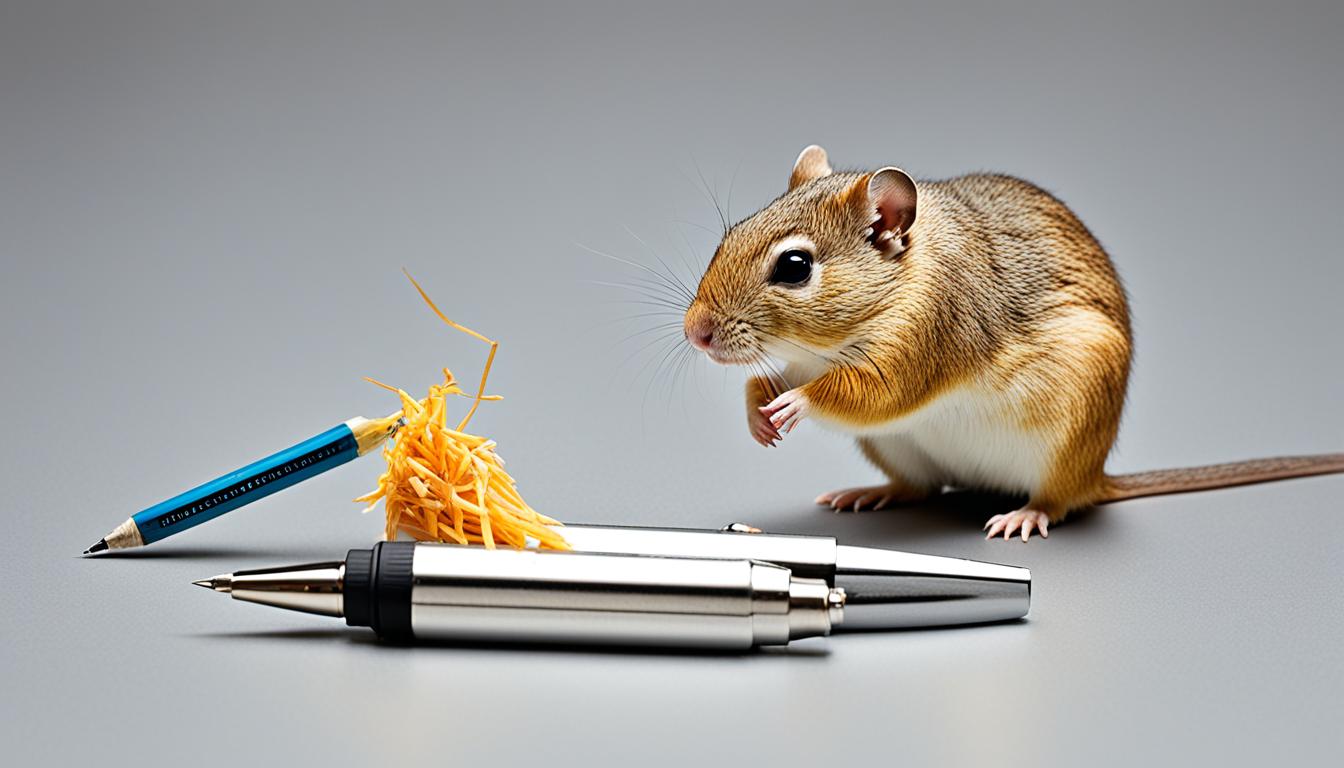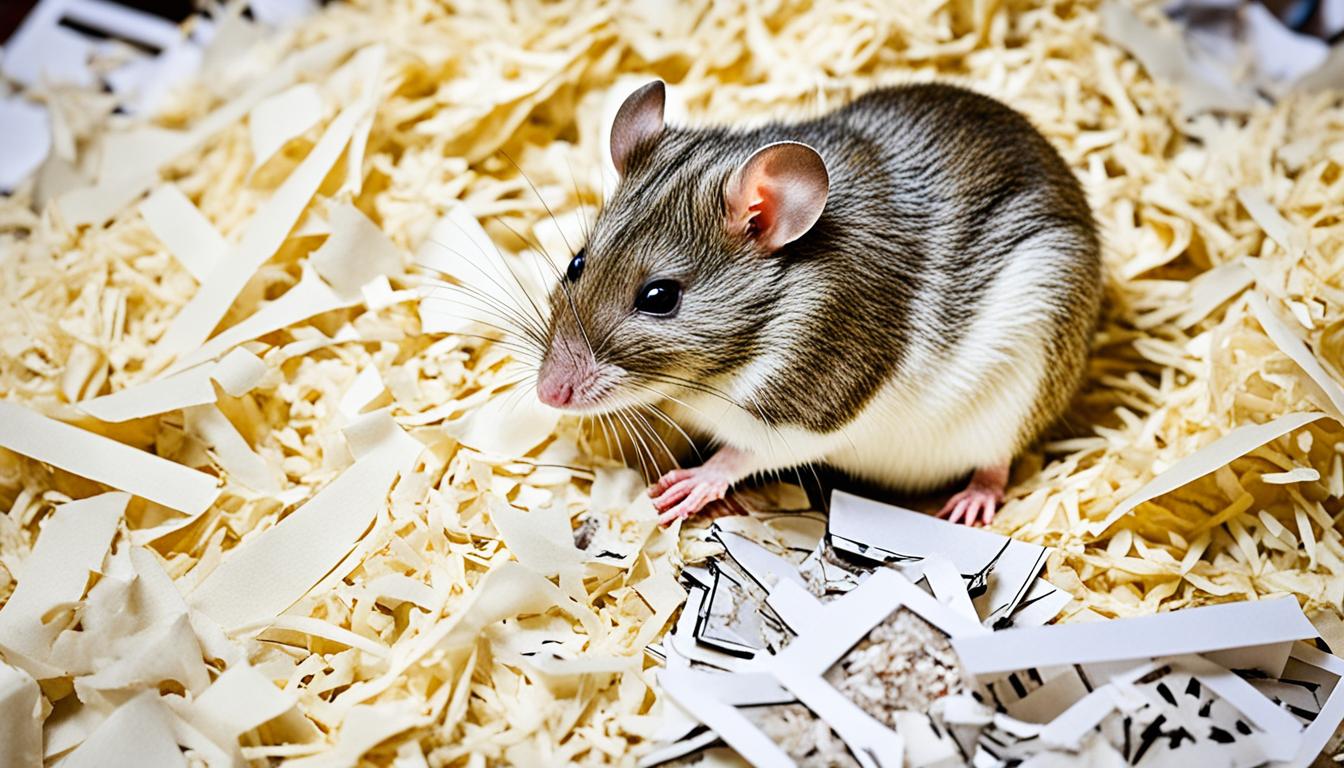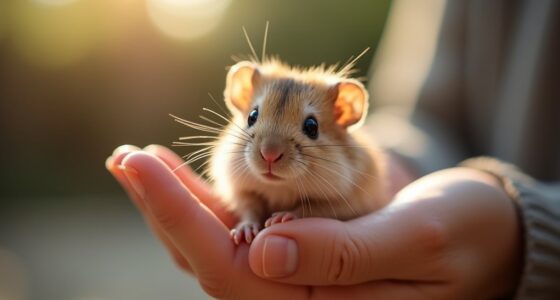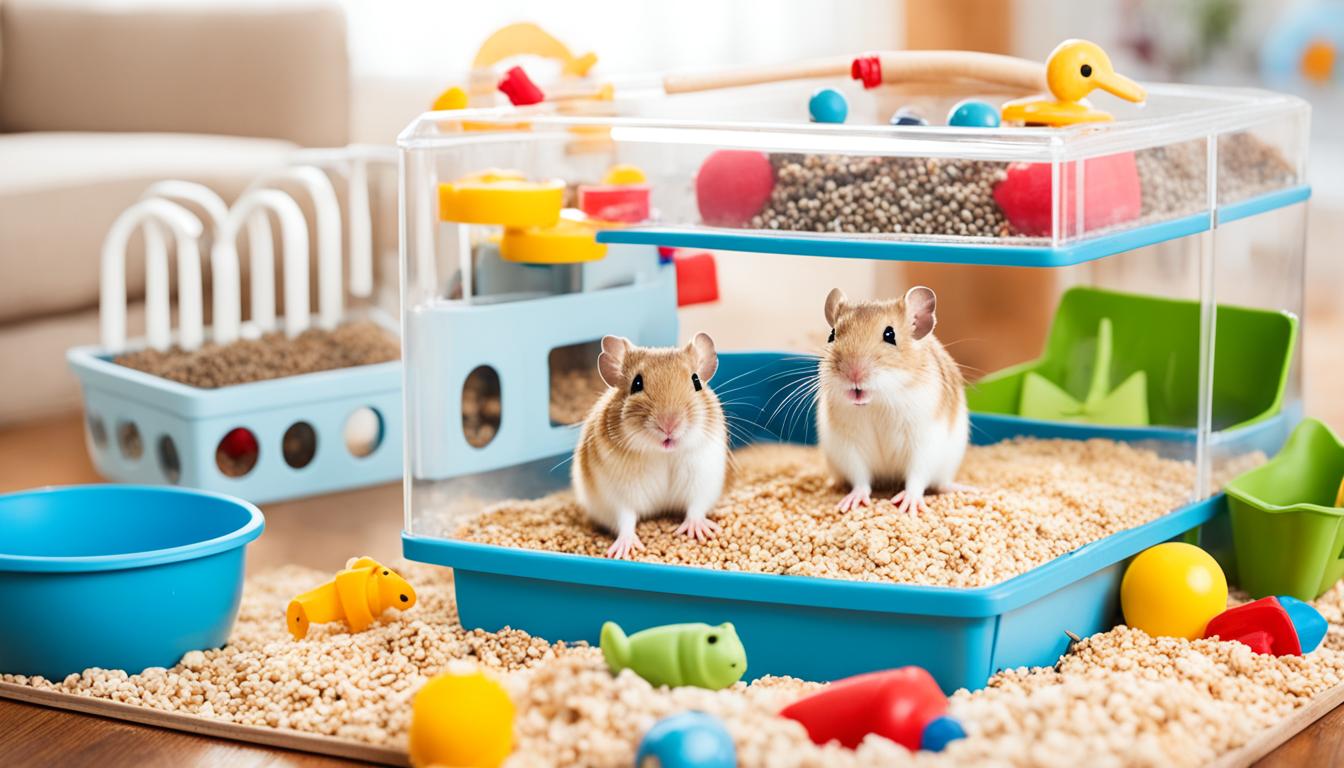Did you know that the average size of a gerbil ranges between 110-135 mm in length and weighs between 60-130 g? Yes, these small rodents might be tiny, but they are surprisingly sturdy for their size! If you’ve ever been curious about how big gerbils are or if they are good pets, then you are in the right place. This article will delve into the intriguing world of gerbil size, covering their physical attributes and behavioral distinctions from other rodents. So, let’s get started and discover the facts about gerbil size!
Key Takeaways:
- Gerbils are typically between 110-135 mm in length and weigh between 60-130 g.
- They have longer bodies, pointed noses, and long hind legs.
- Gerbils make great pets and are sociable animals that thrive in the company of other gerbils.
- Proper care and interaction are essential for gerbil health and happiness.
- Gerbils require a clean and well-ventilated cage, bedding for burrowing, and a balanced diet.
Physical Differences Between Gerbils and Hamsters
Gerbils and hamsters have distinct physical differences. Let’s take a closer look at these adorable rodents!
Gerbils, known for their elongated bodies, have longer noses and hind legs compared to hamsters. They often stand on their hind legs to get a better view of their surroundings. Gerbils also have longer tails that are covered in fur and end in a brushy tuft, which adds to their charm.
On the other hand, hamsters have short and stubby bodies. They have shorter noses than gerbils and stocky legs that give them a plodding waddle when they walk. In addition, hamsters have shorter tails in comparison to gerbils.
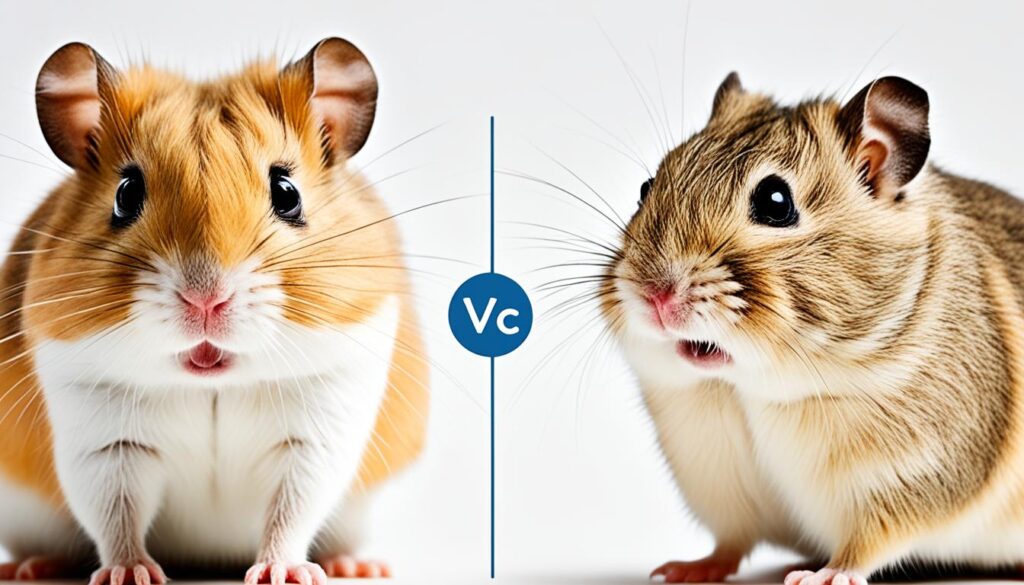
Here is a detailed comparison of the physical differences between gerbils and hamsters:
| Physical Characteristics | Gerbils | Hamsters |
|---|---|---|
| Body Length | Longer | Shorter |
| Nose | Pointed | Short |
| Hind Legs | Long | Stocky |
| Tail | Long, covered in fur, ends in a brushy tuft | Shorter |
As we can see, gerbils and hamsters have clear physical distinctions. These differences add to the uniqueness of each species and make them fascinating pets to observe and care for.
Size Comparison of Gerbils and Hamsters
Gerbils and hamsters have distinct size differences. Understanding the size of these small pets is important, especially for families with small children.
On average, gerbils measure around 5-6 inches in length, excluding their tails, which are typically 3-4 inches long. In terms of weight, adult gerbils range from 2-4 ounces.
Hamsters, on the other hand, vary in size based on their species. Dwarf hamsters, the smallest type, measure approximately 2-4 inches in length and weigh about 1.5 ounces. Syrian hamsters, the largest type of hamster, are larger, with an average length of 5-7 inches and a weight ranging from 4-8 ounces.
The following table provides a visual representation of the size comparison between gerbils and hamsters:
| Gerbils | Hamsters |
|---|---|
| Length: 5-6 inches (excluding tail) | Dwarf: 2-4 inches Syrian: 5-7 inches |
| Weight: 2-4 ounces | Dwarf: 1.5 ounces Syrian: 4-8 ounces |
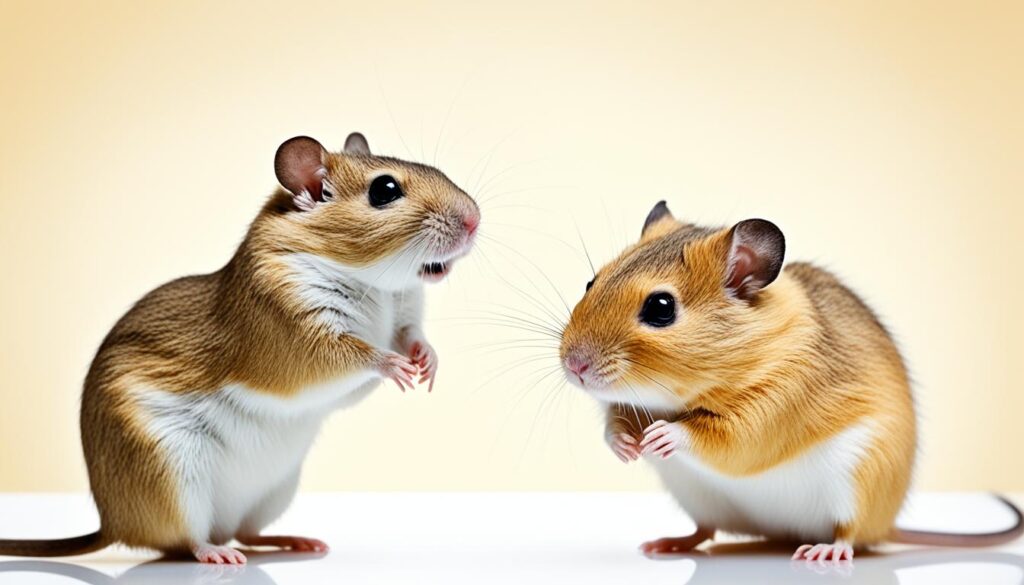 |
The size of the pet can greatly impact the overall experience of owning one. Smaller gerbils may be more suitable for families with limited space, while larger hamsters may be better suited for those looking for a slightly larger and more robust pet.
Choosing the Right Size Pet
When deciding between a gerbil and a hamster, it is important to consider the size that fits best with your lifestyle and living arrangements. If you have limited space, a smaller gerbil may be a better choice. However, if you prefer a slightly larger and more substantial pet, a hamster may be the way to go.
Color Variations in Gerbils and Hamsters
Both gerbils and hamsters come in a wide array of colors, making them visually appealing and diverse as pets. Let’s explore the fascinating color variations in these adorable rodents.
Hamster Colors: Hamsters exhibit a range of coat colors, patterns, and textures. Their hair can be short or long, and they come in various hues, including:
- White
- Cinnamon
- Brown
- Gray
- Black
Some hamsters have a satin sheen fur, giving them a lustrous appearance, while others have wavy hair that adds a unique texture to their coats.
Gerbil Colors: Gerbils also possess a captivating assortment of colors. Their soft, dense fur can be found in shades like:
- Gray
- Tan
- Brown
- Reddish brown
Some gerbil species exhibit dark markings on their heads, while others feature patches of white or buff fur behind their ears. With approximately 40-50 possible colors and combinations, gerbils offer a vibrant palette to choose from.
Now, let’s take a closer look at the charming coat patterns and variations of both gerbils and hamsters.
| Gerbil Coat Colors | Hamster Coat Colors |
|---|---|
| Gray | White |
| Tan | Cinnamon |
| Brown | Brown |
| Reddish brown | Gray |
| Dark markings on head | Black |
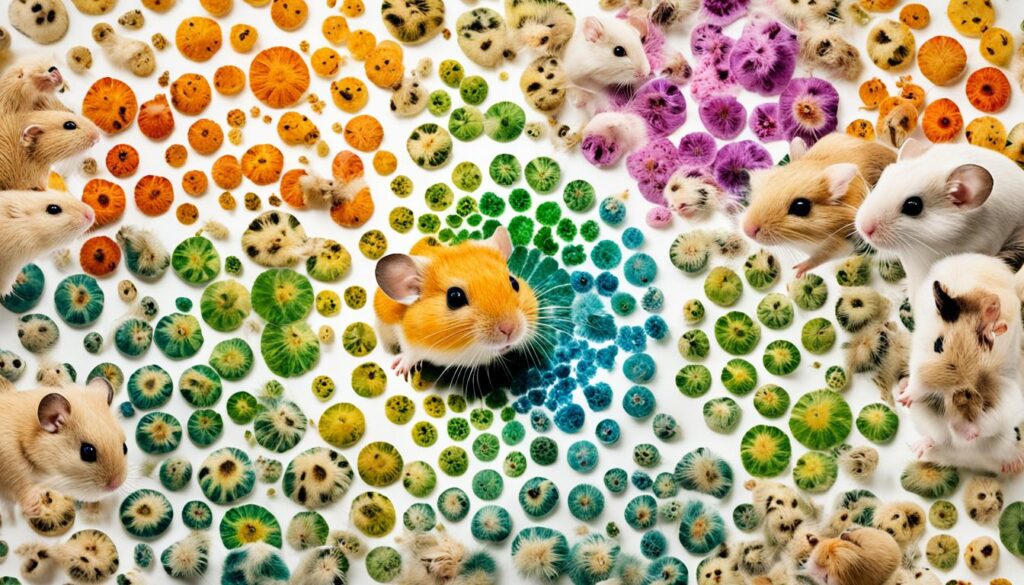
As you can see, both gerbils and hamsters offer a wonderful variety of color options, allowing you to find a pet with the perfect hue to match your preferences. Whether you’re drawn to the subtle elegance of a gray gerbil or the striking beauty of a cinnamon hamster, these small creatures are sure to delight with their captivating colors.
Behavioral Differences Between Gerbils and Hamsters
Gerbils and hamsters display distinct behavioral differences that contribute to their unique personalities as pets. Understanding these differences can help you choose the right furry companion for your lifestyle and preferences.
Gerbil Behavior:
Gerbils are intelligent and inquisitive animals known for their active and playful nature. They exhibit a strong interest in human interaction and enjoy being held and handled. Gerbils are social creatures and thrive when kept with other gerbils, forming close bonds and engaging in playful behaviors. They also appreciate having plenty of mental and physical stimulation, such as toys, tunnels, and nesting materials, to satisfy their natural instincts of digging, gnawing, and shredding.
Hamster Behavior:
Hamsters, on the other hand, are primarily nocturnal creatures with a tendency to be more solitary and territorial. They are less social than gerbils and prefer to have their own space. Hamsters enjoy building elaborate burrows and nests, where they feel safe and secure. They have a keen sense of smell and can recognize their owner’s voice, responding to familiar sounds and scents. While hamsters may not seek out as much human interaction as gerbils, they can still form a bond with their owners through gentle handling and care.
These behavioral differences between gerbils and hamsters highlight the importance of considering your own preferences and lifestyle when choosing a pet. If you enjoy an active and interactive pet that thrives on socialization, a gerbil may be the perfect choice. On the other hand, if you prefer a more independent pet that requires less interaction and is primarily active during the night, a hamster might be a better fit for you.
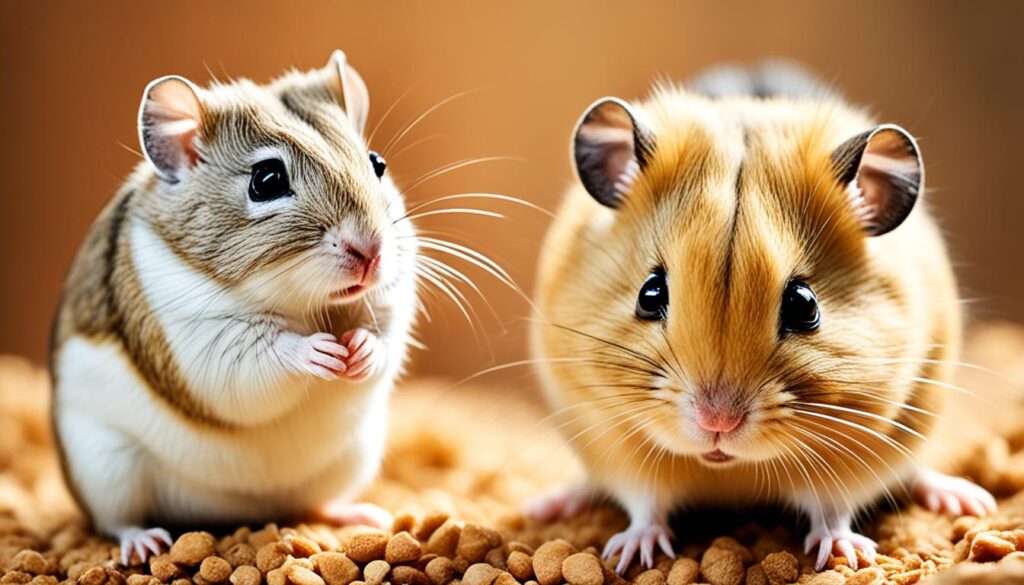
Providing the right environment and enrichment for your pet’s specific behavioral needs is essential for their well-being and happiness. In the next section, we will discuss teething and biting habits of gerbils and hamsters, shedding light on how to ensure a safe and comfortable interaction with your furry friend.
Teething and Biting Habits of Gerbils and Hamsters
Teething is a natural behavior for both gerbils and hamsters. While they share this common characteristic, their biting behaviors differ significantly. It’s important for pet owners to understand these differences in order to provide appropriate care and handling.
Hamsters and Biting
Hamsters may bite if they feel threatened or frightened, or if they are attracted to a scent on a person’s hand. Their instinctual reaction to perceived danger or discomfort can result in a defensive bite. In order to minimize the risk of being bitten, it is recommended to wash your hands before handling a hamster to remove any scents that may trigger this behavior. Maintaining calm and gentle handling techniques will also help to build trust and reduce the likelihood of biting.
Gerbils and Nipping
Gerbils, on the other hand, are generally less prone to biting when properly raised and handled at a young age. While they have ever-growing incisor teeth, which they use primarily for gnawing and grooming, gerbils tend to nip or nibble less frequently compared to hamsters. This is because gerbils typically rely on other forms of communication, such as scent marking and body language, to interact with their environment and other animals.
To keep their teeth healthy, both gerbils and hamsters require appropriate chew toys. These toys not only provide them with a means to satisfy their natural gnawing instincts but also help to keep their teeth properly worn down. Without adequate chew toys, they may resort to inappropriate chewing, which can lead to dental problems.

| Hamsters | Gerbils | |
|---|---|---|
| Teething Habits | Hamsters may bite when threatened or attracted to scents. | Gerbils rarely nip or bite but use their teeth for gnawing and grooming. |
| Care Tips | – Wash hands before handling to remove scents – Use calm and gentle handling techniques – Provide appropriate chew toys |
– Handle gerbils from a young age and socialize them – Monitor teeth and provide chew toys for maintenance |
Sociability of Gerbils and Hamsters
Gerbils and hamsters differ in their sociability. While hamsters are more solitary and territorial, gerbils thrive in the presence of other gerbils. Let’s delve into the social behaviors of these small pets to better understand their sociability.
Hamster Sociability
Hamsters are generally solitary animals and prefer to have their own space. They can be territorial and may exhibit aggressive behavior towards other hamsters, often resulting in fights that can be fatal. However, there are exceptions to this rule, particularly with dwarf hamsters.
Dwarf hamsters, such as Roborovski and Campbell’s hamsters, have a higher tolerance for social interactions with their own kind. When they are born and raised together, they can successfully live together as long as they have adequate space and resources.
Nevertheless, it’s essential to provide a spacious and enriched environment for dwarf hamsters to minimize territorial disputes and promote a harmonious living arrangement.
Gerbil Sociability
Gerbils, on the other hand, are highly social animals that thrive in the company of other gerbils. They exhibit complex social behaviors and form strong bonds with their companions. It is recommended to keep gerbils in pairs or groups, preferably with even numbers.
Gerbils not only enjoy the companionship of their fellow gerbils but also actively engage with humans. They are highly curious about their environment and readily interact with their owners.
To illustrate the sociability difference between gerbils and hamsters, here is a table summarizing their social behavior:
| Hamsters | Gerbils | |
|---|---|---|
| Sociability | Solitary | Social, prefer companionship |
| Tolerance for Same-Species | Varies; usually low | High; enjoy living in pairs/groups |
| Interaction with Humans | Varies; less interactive | Curious and interactive |
| Special Considerations | Dwarf hamsters can live together if raised together | Prefer even numbers for groupings |
To enhance the social well-being of gerbils and hamsters, it’s crucial to understand their individual sociability needs and provide appropriate housing and companionship.

Care Requirements for Gerbils and Hamsters
Gerbils and hamsters have similar care requirements. To ensure their well-being, it is important to provide them with the appropriate living conditions and a balanced diet.
Housing
Both gerbils and hamsters need a clean and well-ventilated cage with a solid base. This will prevent them from escaping and protect them from drafts. Gerbils require a minimum of 5 gallons of aquarium tank space per gerbil, while hamsters need at least 3 feet of unbroken floor space in their cage. This allows them to roam, exercise, and explore their surroundings.
Bedding
Plenty of bedding should be provided for both gerbils and hamsters to satisfy their natural burrowing instincts. Choose a bedding material that is safe and comfortable for them, such as aspen shavings, paper bedding, or unscented recycled paper pellets. Avoid using cedar or pine bedding as they can be harmful to their respiratory system.
Enrichment
Gerbils and hamsters are active creatures who need mental and physical stimulation. Provide them with chew toys, tunnels, and hideouts to keep them entertained and engaged. An exercise wheel is essential to allow them to burn off their energy and maintain their physical health.
Cleaning
Regular cage maintenance is crucial for the health and well-being of gerbils and hamsters. Gerbil tanks should be cleaned every two weeks, while hamster cages require spot cleaning and full clean outs every 4-5 weeks. This includes removing soiled bedding, wiping down surfaces with a pet-safe disinfectant, and replenishing fresh bedding.
Nutrition
A balanced diet is essential for the health of gerbils and hamsters. Both should be given a mix of grains, fruits, vegetables, and protein. Commercial pellet food specially formulated for rodents can serve as a base, supplemented with fresh foods. Ensure they always have access to clean, fresh water in a water bottle.
| Gerbils | Hamsters | |
|---|---|---|
| Recommended Cage Size | 5 gallons of aquarium tank space per gerbil | 3 feet of unbroken floor space |
| Cage Cleaning | Every two weeks | Spot cleaning and full clean outs every 4-5 weeks |
| Bedding | Aspen shavings, paper bedding, unscented recycled paper pellets | Aspen shavings, paper bedding, unscented recycled paper pellets |
| Enrichment | Chew toys, tunnels, hideouts, exercise wheel | Chew toys, tunnels, hideouts, exercise wheel |
| Nutrition | Grains, fruits, vegetables, protein | Grains, fruits, vegetables, protein |
Providing proper care for gerbils and hamsters is essential for their overall health and happiness. By meeting their specific housing, bedding, enrichment, cleaning, and nutritional needs, you can ensure a thriving and fulfilling life for these adorable pets.
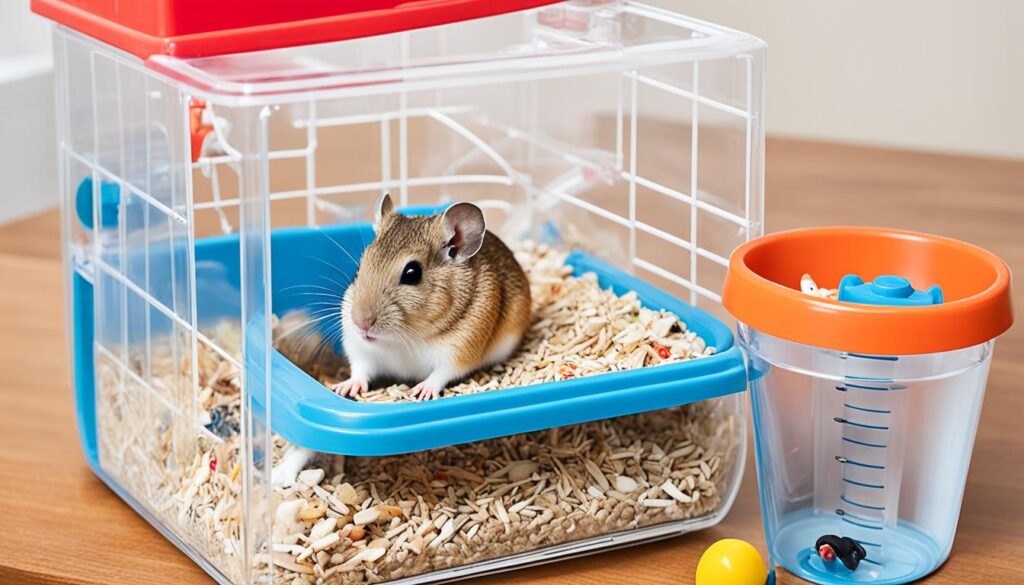
Conclusion
Gerbils are fascinating rodents that make great pets. With their larger size compared to hamsters, gerbils exhibit unique physical and behavioral traits. They are intelligent, active, and social animals that thrive on daily interaction and companionship. To ensure their well-being, gerbils require a clean and stimulating environment, along with proper nutrition and plenty of space for burrowing and exercise.
Understanding the specific needs of gerbils, such as their size, behavior, and care requirements, is crucial for providing them with a happy and healthy life. By creating a suitable habitat that includes a spacious cage or tank, appropriate bedding, and engaging toys, gerbil owners can support their pets’ natural behaviors and provide them with opportunities for mental and physical stimulation.
Additionally, providing a balanced diet that includes a variety of grains, fruits, vegetables, and protein is essential for gerbil health. Regular cleaning of their habitat, including spot cleaning and full cleanouts as recommended, helps maintain a hygienic and comfortable environment for these curious and social creatures. When well-cared for, gerbils can bring joy and companionship to families and individuals alike.
In conclusion, gerbils are a wonderful choice for those seeking an engaging and interactive pet. Their unique size, behavior, and care needs set them apart from other rodents, such as hamsters. By understanding and meeting these requirements, gerbil owners can create a nurturing environment that promotes their pets’ well-being and happiness.
